Strategic Analysis of Starbucks: Business Operations and Strategies
VerifiedAdded on 2019/12/28
|15
|4185
|99
Report
AI Summary
This report provides a comprehensive strategic management analysis of Starbucks, a multinational coffeehouse chain. It begins with an introduction to strategic management and an overview of Starbucks' business operations, including its global presence and brand identity. The report then delves into strategic analysis, examining both internal and external factors. Internal analysis covers logistics, marketing, service, infrastructure, human resource management, and technological development. External analysis employs the PEST model to assess political, economic, social, and technological factors impacting Starbucks. Competitive analysis utilizes Porter's Five Forces to evaluate the company's competitive position. The report also includes a stakeholder analysis, identifying key stakeholders such as investors, employees, consumers, suppliers, and government, and discusses the strategies Starbucks employs to manage these stakeholders. The report concludes with a summary of the strategic insights gained and provides references to supporting literature.
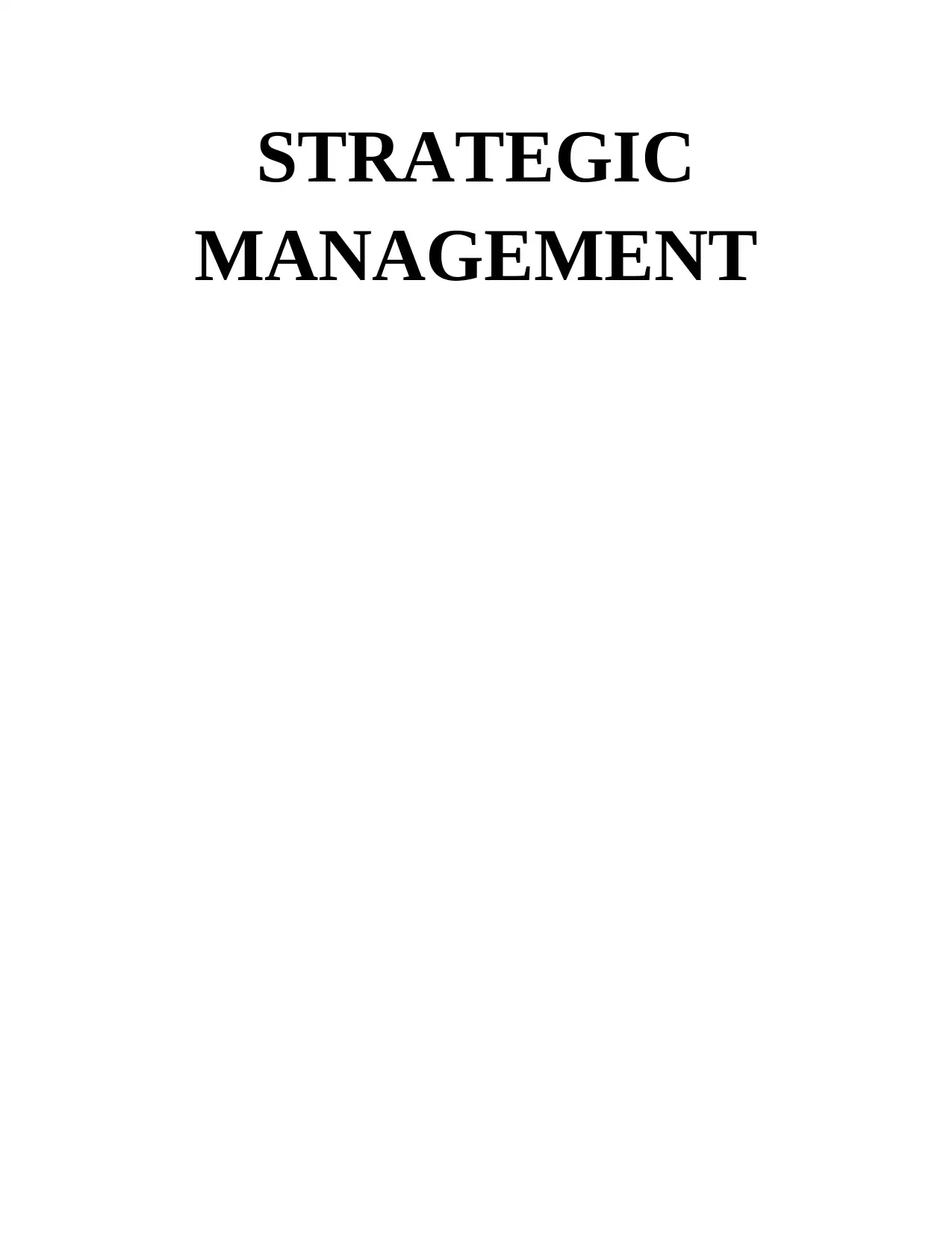
STRATEGIC
MANAGEMENT
MANAGEMENT
Paraphrase This Document
Need a fresh take? Get an instant paraphrase of this document with our AI Paraphraser
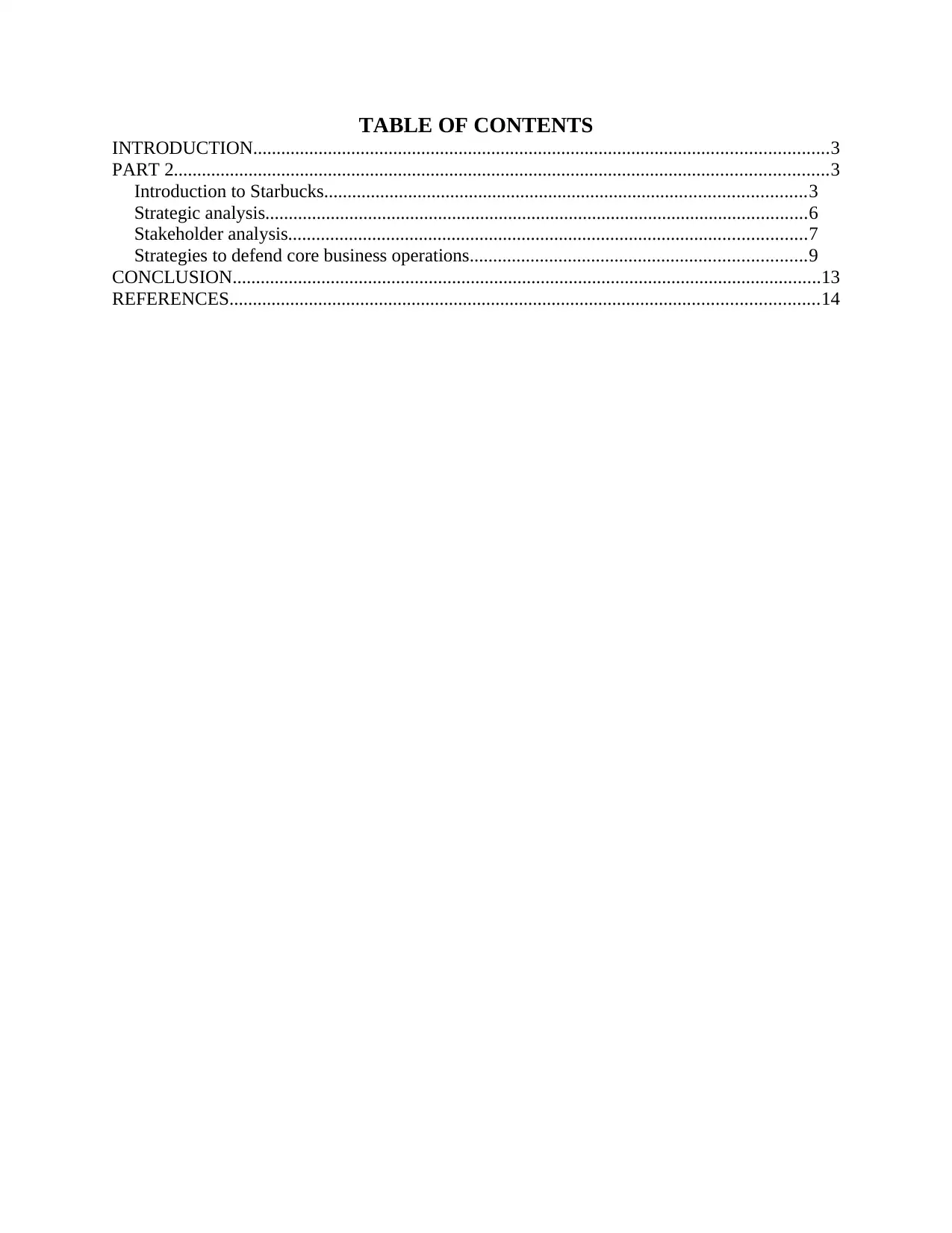
TABLE OF CONTENTS
INTRODUCTION...........................................................................................................................3
PART 2............................................................................................................................................3
Introduction to Starbucks.......................................................................................................3
Strategic analysis....................................................................................................................6
Stakeholder analysis...............................................................................................................7
Strategies to defend core business operations........................................................................9
CONCLUSION..............................................................................................................................13
REFERENCES..............................................................................................................................14
INTRODUCTION...........................................................................................................................3
PART 2............................................................................................................................................3
Introduction to Starbucks.......................................................................................................3
Strategic analysis....................................................................................................................6
Stakeholder analysis...............................................................................................................7
Strategies to defend core business operations........................................................................9
CONCLUSION..............................................................................................................................13
REFERENCES..............................................................................................................................14
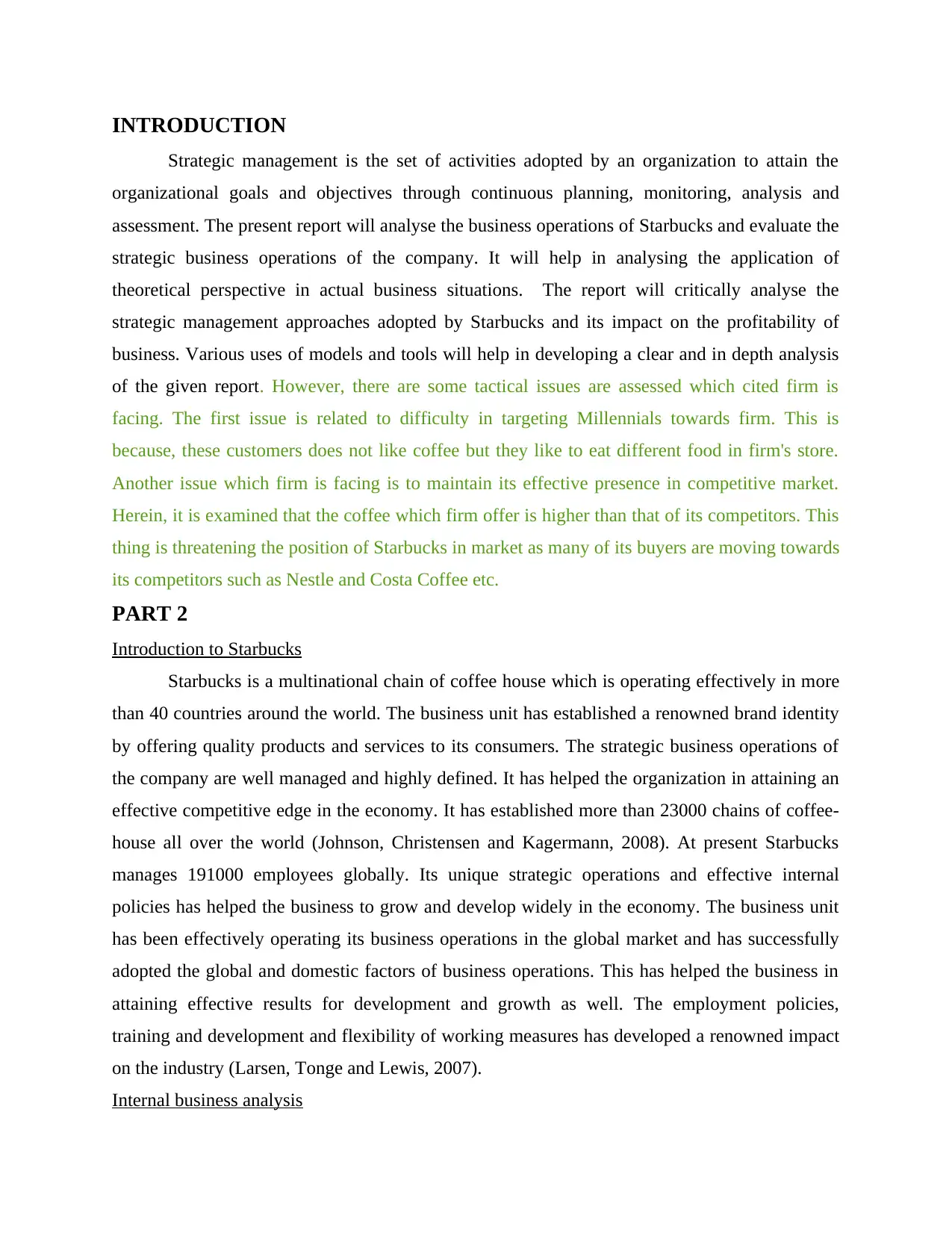
INTRODUCTION
Strategic management is the set of activities adopted by an organization to attain the
organizational goals and objectives through continuous planning, monitoring, analysis and
assessment. The present report will analyse the business operations of Starbucks and evaluate the
strategic business operations of the company. It will help in analysing the application of
theoretical perspective in actual business situations. The report will critically analyse the
strategic management approaches adopted by Starbucks and its impact on the profitability of
business. Various uses of models and tools will help in developing a clear and in depth analysis
of the given report. However, there are some tactical issues are assessed which cited firm is
facing. The first issue is related to difficulty in targeting Millennials towards firm. This is
because, these customers does not like coffee but they like to eat different food in firm's store.
Another issue which firm is facing is to maintain its effective presence in competitive market.
Herein, it is examined that the coffee which firm offer is higher than that of its competitors. This
thing is threatening the position of Starbucks in market as many of its buyers are moving towards
its competitors such as Nestle and Costa Coffee etc.
PART 2
Introduction to Starbucks
Starbucks is a multinational chain of coffee house which is operating effectively in more
than 40 countries around the world. The business unit has established a renowned brand identity
by offering quality products and services to its consumers. The strategic business operations of
the company are well managed and highly defined. It has helped the organization in attaining an
effective competitive edge in the economy. It has established more than 23000 chains of coffee-
house all over the world (Johnson, Christensen and Kagermann, 2008). At present Starbucks
manages 191000 employees globally. Its unique strategic operations and effective internal
policies has helped the business to grow and develop widely in the economy. The business unit
has been effectively operating its business operations in the global market and has successfully
adopted the global and domestic factors of business operations. This has helped the business in
attaining effective results for development and growth as well. The employment policies,
training and development and flexibility of working measures has developed a renowned impact
on the industry (Larsen, Tonge and Lewis, 2007).
Internal business analysis
Strategic management is the set of activities adopted by an organization to attain the
organizational goals and objectives through continuous planning, monitoring, analysis and
assessment. The present report will analyse the business operations of Starbucks and evaluate the
strategic business operations of the company. It will help in analysing the application of
theoretical perspective in actual business situations. The report will critically analyse the
strategic management approaches adopted by Starbucks and its impact on the profitability of
business. Various uses of models and tools will help in developing a clear and in depth analysis
of the given report. However, there are some tactical issues are assessed which cited firm is
facing. The first issue is related to difficulty in targeting Millennials towards firm. This is
because, these customers does not like coffee but they like to eat different food in firm's store.
Another issue which firm is facing is to maintain its effective presence in competitive market.
Herein, it is examined that the coffee which firm offer is higher than that of its competitors. This
thing is threatening the position of Starbucks in market as many of its buyers are moving towards
its competitors such as Nestle and Costa Coffee etc.
PART 2
Introduction to Starbucks
Starbucks is a multinational chain of coffee house which is operating effectively in more
than 40 countries around the world. The business unit has established a renowned brand identity
by offering quality products and services to its consumers. The strategic business operations of
the company are well managed and highly defined. It has helped the organization in attaining an
effective competitive edge in the economy. It has established more than 23000 chains of coffee-
house all over the world (Johnson, Christensen and Kagermann, 2008). At present Starbucks
manages 191000 employees globally. Its unique strategic operations and effective internal
policies has helped the business to grow and develop widely in the economy. The business unit
has been effectively operating its business operations in the global market and has successfully
adopted the global and domestic factors of business operations. This has helped the business in
attaining effective results for development and growth as well. The employment policies,
training and development and flexibility of working measures has developed a renowned impact
on the industry (Larsen, Tonge and Lewis, 2007).
Internal business analysis
⊘ This is a preview!⊘
Do you want full access?
Subscribe today to unlock all pages.

Trusted by 1+ million students worldwide
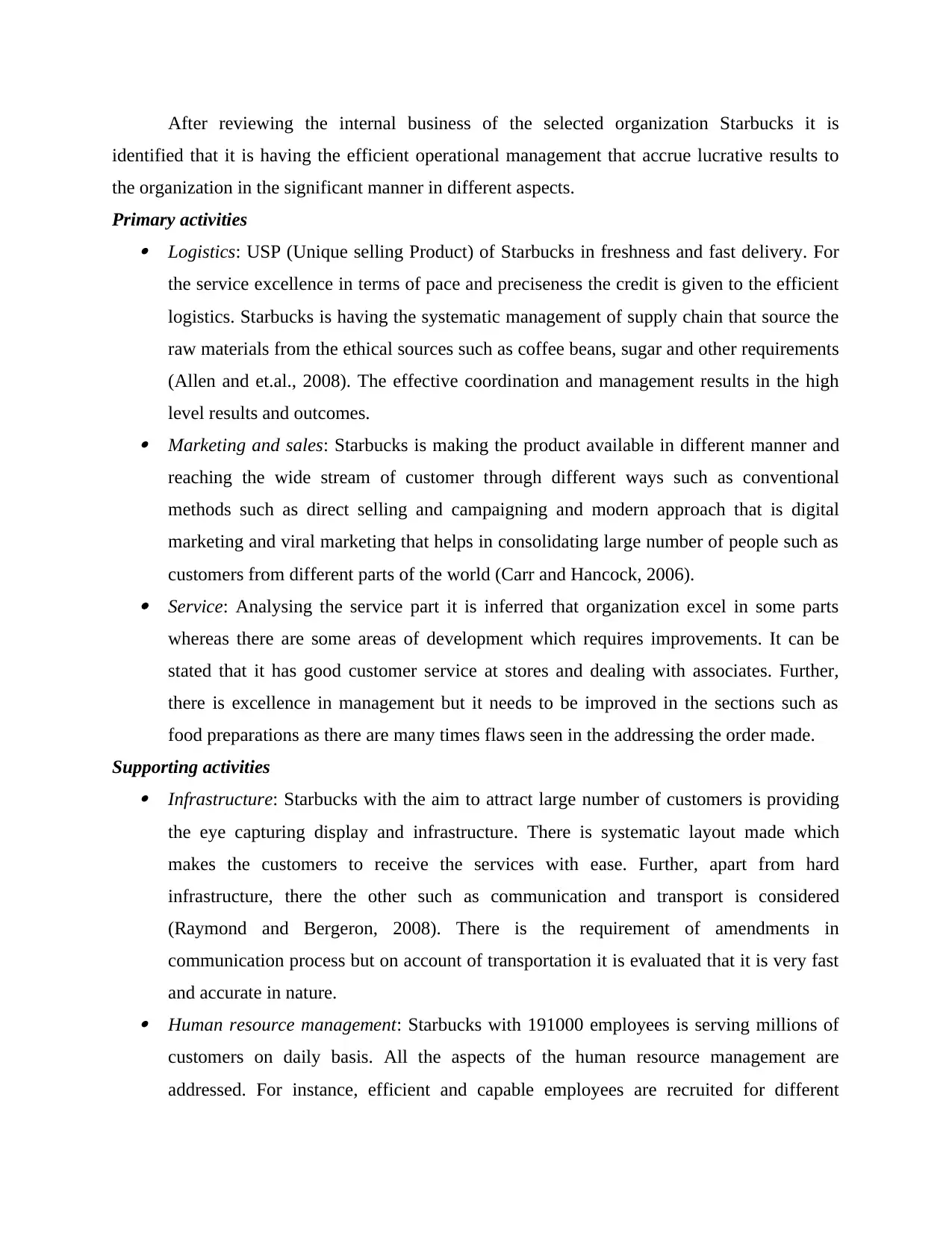
After reviewing the internal business of the selected organization Starbucks it is
identified that it is having the efficient operational management that accrue lucrative results to
the organization in the significant manner in different aspects.
Primary activities Logistics: USP (Unique selling Product) of Starbucks in freshness and fast delivery. For
the service excellence in terms of pace and preciseness the credit is given to the efficient
logistics. Starbucks is having the systematic management of supply chain that source the
raw materials from the ethical sources such as coffee beans, sugar and other requirements
(Allen and et.al., 2008). The effective coordination and management results in the high
level results and outcomes. Marketing and sales: Starbucks is making the product available in different manner and
reaching the wide stream of customer through different ways such as conventional
methods such as direct selling and campaigning and modern approach that is digital
marketing and viral marketing that helps in consolidating large number of people such as
customers from different parts of the world (Carr and Hancock, 2006). Service: Analysing the service part it is inferred that organization excel in some parts
whereas there are some areas of development which requires improvements. It can be
stated that it has good customer service at stores and dealing with associates. Further,
there is excellence in management but it needs to be improved in the sections such as
food preparations as there are many times flaws seen in the addressing the order made.
Supporting activities Infrastructure: Starbucks with the aim to attract large number of customers is providing
the eye capturing display and infrastructure. There is systematic layout made which
makes the customers to receive the services with ease. Further, apart from hard
infrastructure, there the other such as communication and transport is considered
(Raymond and Bergeron, 2008). There is the requirement of amendments in
communication process but on account of transportation it is evaluated that it is very fast
and accurate in nature. Human resource management: Starbucks with 191000 employees is serving millions of
customers on daily basis. All the aspects of the human resource management are
addressed. For instance, efficient and capable employees are recruited for different
identified that it is having the efficient operational management that accrue lucrative results to
the organization in the significant manner in different aspects.
Primary activities Logistics: USP (Unique selling Product) of Starbucks in freshness and fast delivery. For
the service excellence in terms of pace and preciseness the credit is given to the efficient
logistics. Starbucks is having the systematic management of supply chain that source the
raw materials from the ethical sources such as coffee beans, sugar and other requirements
(Allen and et.al., 2008). The effective coordination and management results in the high
level results and outcomes. Marketing and sales: Starbucks is making the product available in different manner and
reaching the wide stream of customer through different ways such as conventional
methods such as direct selling and campaigning and modern approach that is digital
marketing and viral marketing that helps in consolidating large number of people such as
customers from different parts of the world (Carr and Hancock, 2006). Service: Analysing the service part it is inferred that organization excel in some parts
whereas there are some areas of development which requires improvements. It can be
stated that it has good customer service at stores and dealing with associates. Further,
there is excellence in management but it needs to be improved in the sections such as
food preparations as there are many times flaws seen in the addressing the order made.
Supporting activities Infrastructure: Starbucks with the aim to attract large number of customers is providing
the eye capturing display and infrastructure. There is systematic layout made which
makes the customers to receive the services with ease. Further, apart from hard
infrastructure, there the other such as communication and transport is considered
(Raymond and Bergeron, 2008). There is the requirement of amendments in
communication process but on account of transportation it is evaluated that it is very fast
and accurate in nature. Human resource management: Starbucks with 191000 employees is serving millions of
customers on daily basis. All the aspects of the human resource management are
addressed. For instance, efficient and capable employees are recruited for different
Paraphrase This Document
Need a fresh take? Get an instant paraphrase of this document with our AI Paraphraser
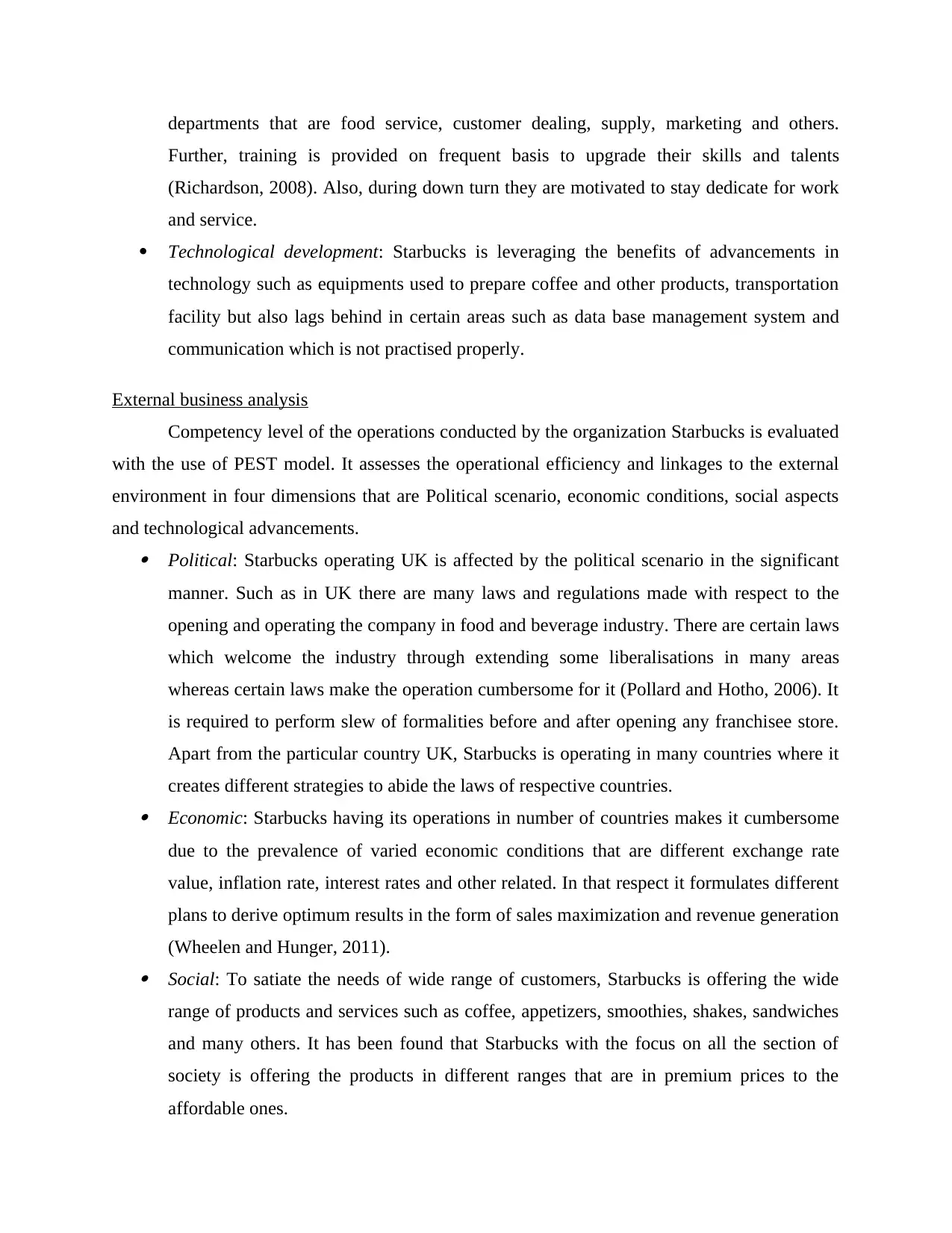
departments that are food service, customer dealing, supply, marketing and others.
Further, training is provided on frequent basis to upgrade their skills and talents
(Richardson, 2008). Also, during down turn they are motivated to stay dedicate for work
and service.
Technological development: Starbucks is leveraging the benefits of advancements in
technology such as equipments used to prepare coffee and other products, transportation
facility but also lags behind in certain areas such as data base management system and
communication which is not practised properly.
External business analysis
Competency level of the operations conducted by the organization Starbucks is evaluated
with the use of PEST model. It assesses the operational efficiency and linkages to the external
environment in four dimensions that are Political scenario, economic conditions, social aspects
and technological advancements. Political: Starbucks operating UK is affected by the political scenario in the significant
manner. Such as in UK there are many laws and regulations made with respect to the
opening and operating the company in food and beverage industry. There are certain laws
which welcome the industry through extending some liberalisations in many areas
whereas certain laws make the operation cumbersome for it (Pollard and Hotho, 2006). It
is required to perform slew of formalities before and after opening any franchisee store.
Apart from the particular country UK, Starbucks is operating in many countries where it
creates different strategies to abide the laws of respective countries. Economic: Starbucks having its operations in number of countries makes it cumbersome
due to the prevalence of varied economic conditions that are different exchange rate
value, inflation rate, interest rates and other related. In that respect it formulates different
plans to derive optimum results in the form of sales maximization and revenue generation
(Wheelen and Hunger, 2011). Social: To satiate the needs of wide range of customers, Starbucks is offering the wide
range of products and services such as coffee, appetizers, smoothies, shakes, sandwiches
and many others. It has been found that Starbucks with the focus on all the section of
society is offering the products in different ranges that are in premium prices to the
affordable ones.
Further, training is provided on frequent basis to upgrade their skills and talents
(Richardson, 2008). Also, during down turn they are motivated to stay dedicate for work
and service.
Technological development: Starbucks is leveraging the benefits of advancements in
technology such as equipments used to prepare coffee and other products, transportation
facility but also lags behind in certain areas such as data base management system and
communication which is not practised properly.
External business analysis
Competency level of the operations conducted by the organization Starbucks is evaluated
with the use of PEST model. It assesses the operational efficiency and linkages to the external
environment in four dimensions that are Political scenario, economic conditions, social aspects
and technological advancements. Political: Starbucks operating UK is affected by the political scenario in the significant
manner. Such as in UK there are many laws and regulations made with respect to the
opening and operating the company in food and beverage industry. There are certain laws
which welcome the industry through extending some liberalisations in many areas
whereas certain laws make the operation cumbersome for it (Pollard and Hotho, 2006). It
is required to perform slew of formalities before and after opening any franchisee store.
Apart from the particular country UK, Starbucks is operating in many countries where it
creates different strategies to abide the laws of respective countries. Economic: Starbucks having its operations in number of countries makes it cumbersome
due to the prevalence of varied economic conditions that are different exchange rate
value, inflation rate, interest rates and other related. In that respect it formulates different
plans to derive optimum results in the form of sales maximization and revenue generation
(Wheelen and Hunger, 2011). Social: To satiate the needs of wide range of customers, Starbucks is offering the wide
range of products and services such as coffee, appetizers, smoothies, shakes, sandwiches
and many others. It has been found that Starbucks with the focus on all the section of
society is offering the products in different ranges that are in premium prices to the
affordable ones.
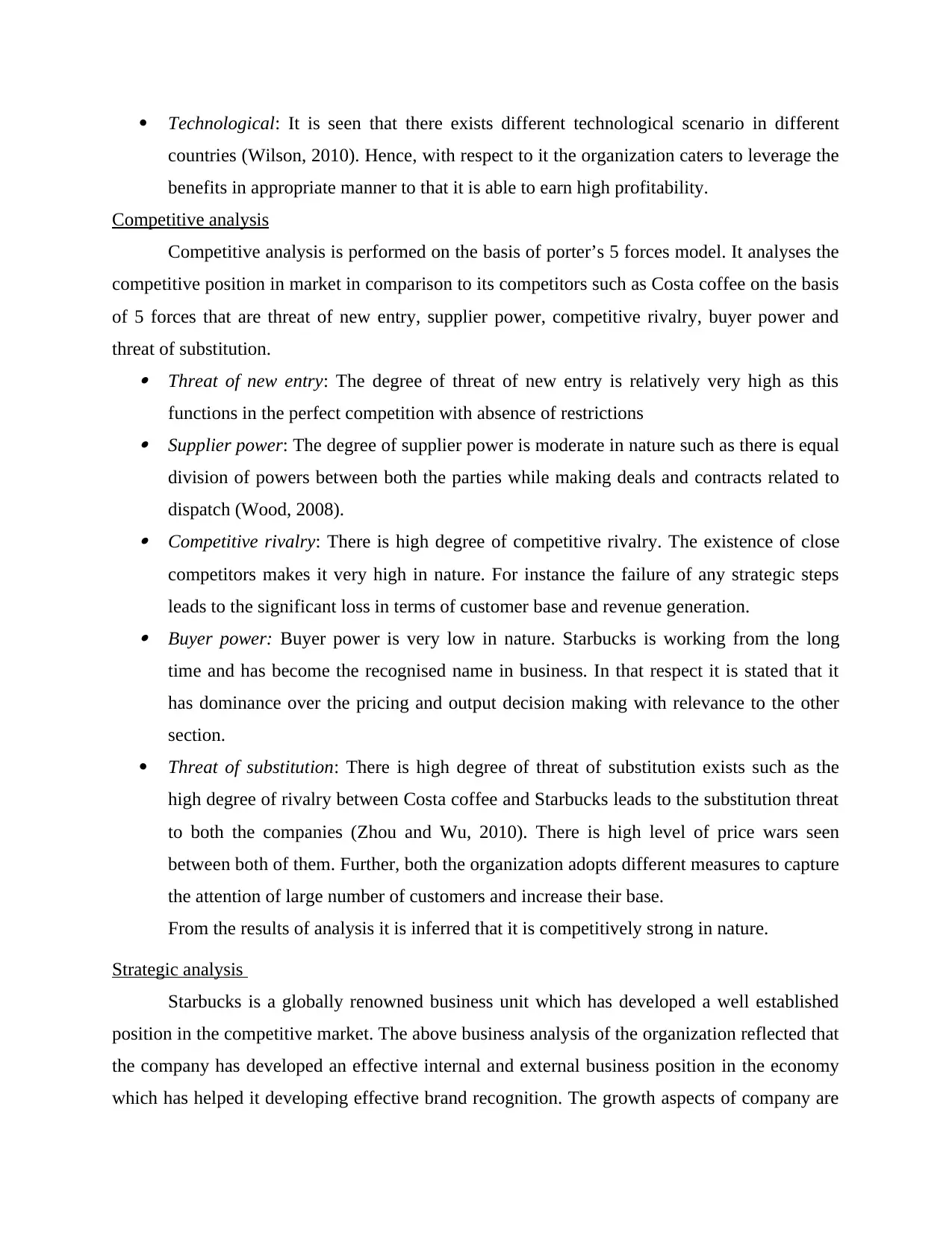
Technological: It is seen that there exists different technological scenario in different
countries (Wilson, 2010). Hence, with respect to it the organization caters to leverage the
benefits in appropriate manner to that it is able to earn high profitability.
Competitive analysis
Competitive analysis is performed on the basis of porter’s 5 forces model. It analyses the
competitive position in market in comparison to its competitors such as Costa coffee on the basis
of 5 forces that are threat of new entry, supplier power, competitive rivalry, buyer power and
threat of substitution. Threat of new entry: The degree of threat of new entry is relatively very high as this
functions in the perfect competition with absence of restrictions Supplier power: The degree of supplier power is moderate in nature such as there is equal
division of powers between both the parties while making deals and contracts related to
dispatch (Wood, 2008). Competitive rivalry: There is high degree of competitive rivalry. The existence of close
competitors makes it very high in nature. For instance the failure of any strategic steps
leads to the significant loss in terms of customer base and revenue generation. Buyer power: Buyer power is very low in nature. Starbucks is working from the long
time and has become the recognised name in business. In that respect it is stated that it
has dominance over the pricing and output decision making with relevance to the other
section.
Threat of substitution: There is high degree of threat of substitution exists such as the
high degree of rivalry between Costa coffee and Starbucks leads to the substitution threat
to both the companies (Zhou and Wu, 2010). There is high level of price wars seen
between both of them. Further, both the organization adopts different measures to capture
the attention of large number of customers and increase their base.
From the results of analysis it is inferred that it is competitively strong in nature.
Strategic analysis
Starbucks is a globally renowned business unit which has developed a well established
position in the competitive market. The above business analysis of the organization reflected that
the company has developed an effective internal and external business position in the economy
which has helped it developing effective brand recognition. The growth aspects of company are
countries (Wilson, 2010). Hence, with respect to it the organization caters to leverage the
benefits in appropriate manner to that it is able to earn high profitability.
Competitive analysis
Competitive analysis is performed on the basis of porter’s 5 forces model. It analyses the
competitive position in market in comparison to its competitors such as Costa coffee on the basis
of 5 forces that are threat of new entry, supplier power, competitive rivalry, buyer power and
threat of substitution. Threat of new entry: The degree of threat of new entry is relatively very high as this
functions in the perfect competition with absence of restrictions Supplier power: The degree of supplier power is moderate in nature such as there is equal
division of powers between both the parties while making deals and contracts related to
dispatch (Wood, 2008). Competitive rivalry: There is high degree of competitive rivalry. The existence of close
competitors makes it very high in nature. For instance the failure of any strategic steps
leads to the significant loss in terms of customer base and revenue generation. Buyer power: Buyer power is very low in nature. Starbucks is working from the long
time and has become the recognised name in business. In that respect it is stated that it
has dominance over the pricing and output decision making with relevance to the other
section.
Threat of substitution: There is high degree of threat of substitution exists such as the
high degree of rivalry between Costa coffee and Starbucks leads to the substitution threat
to both the companies (Zhou and Wu, 2010). There is high level of price wars seen
between both of them. Further, both the organization adopts different measures to capture
the attention of large number of customers and increase their base.
From the results of analysis it is inferred that it is competitively strong in nature.
Strategic analysis
Starbucks is a globally renowned business unit which has developed a well established
position in the competitive market. The above business analysis of the organization reflected that
the company has developed an effective internal and external business position in the economy
which has helped it developing effective brand recognition. The growth aspects of company are
⊘ This is a preview!⊘
Do you want full access?
Subscribe today to unlock all pages.

Trusted by 1+ million students worldwide
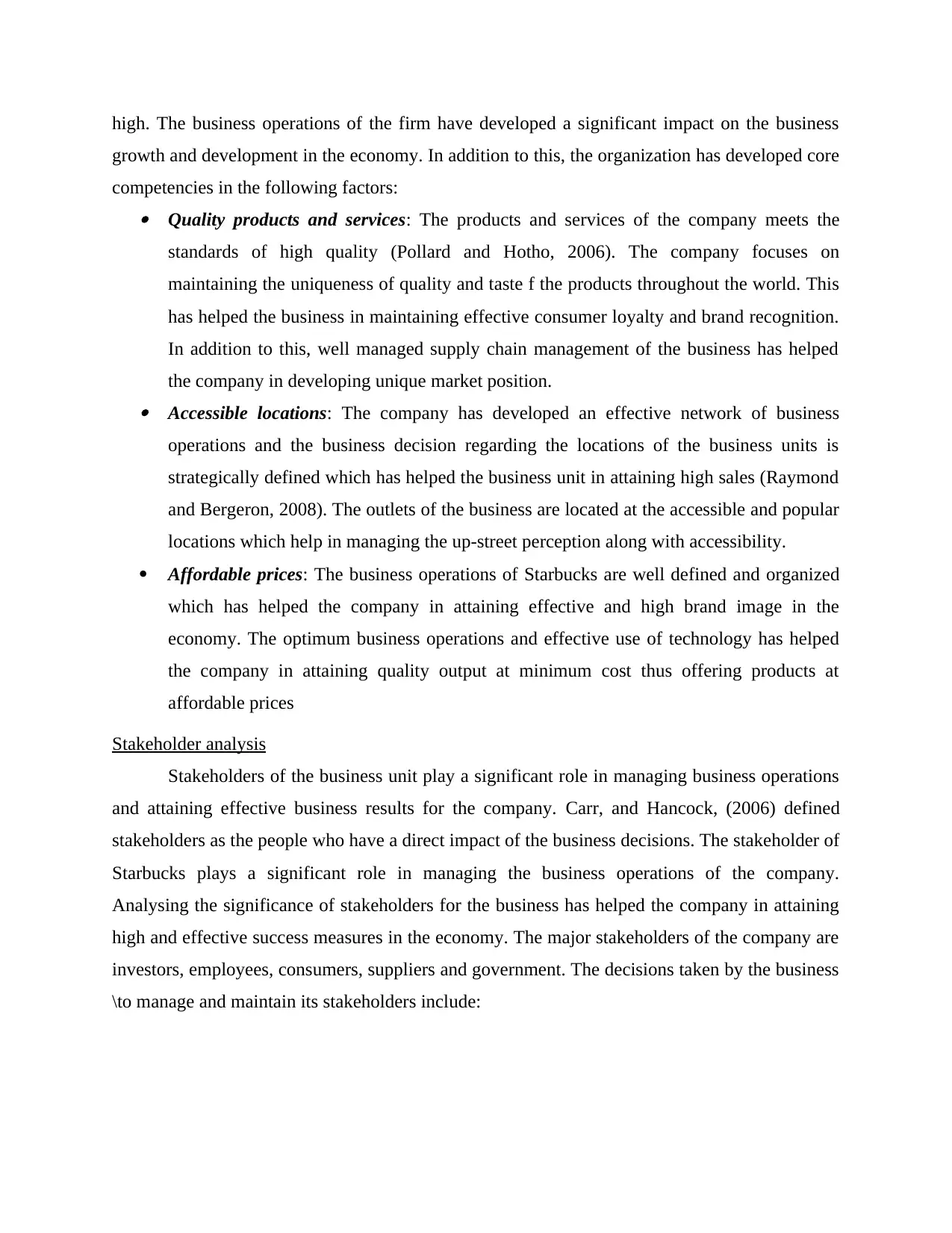
high. The business operations of the firm have developed a significant impact on the business
growth and development in the economy. In addition to this, the organization has developed core
competencies in the following factors: Quality products and services: The products and services of the company meets the
standards of high quality (Pollard and Hotho, 2006). The company focuses on
maintaining the uniqueness of quality and taste f the products throughout the world. This
has helped the business in maintaining effective consumer loyalty and brand recognition.
In addition to this, well managed supply chain management of the business has helped
the company in developing unique market position. Accessible locations: The company has developed an effective network of business
operations and the business decision regarding the locations of the business units is
strategically defined which has helped the business unit in attaining high sales (Raymond
and Bergeron, 2008). The outlets of the business are located at the accessible and popular
locations which help in managing the up-street perception along with accessibility.
Affordable prices: The business operations of Starbucks are well defined and organized
which has helped the company in attaining effective and high brand image in the
economy. The optimum business operations and effective use of technology has helped
the company in attaining quality output at minimum cost thus offering products at
affordable prices
Stakeholder analysis
Stakeholders of the business unit play a significant role in managing business operations
and attaining effective business results for the company. Carr, and Hancock, (2006) defined
stakeholders as the people who have a direct impact of the business decisions. The stakeholder of
Starbucks plays a significant role in managing the business operations of the company.
Analysing the significance of stakeholders for the business has helped the company in attaining
high and effective success measures in the economy. The major stakeholders of the company are
investors, employees, consumers, suppliers and government. The decisions taken by the business
\to manage and maintain its stakeholders include:
growth and development in the economy. In addition to this, the organization has developed core
competencies in the following factors: Quality products and services: The products and services of the company meets the
standards of high quality (Pollard and Hotho, 2006). The company focuses on
maintaining the uniqueness of quality and taste f the products throughout the world. This
has helped the business in maintaining effective consumer loyalty and brand recognition.
In addition to this, well managed supply chain management of the business has helped
the company in developing unique market position. Accessible locations: The company has developed an effective network of business
operations and the business decision regarding the locations of the business units is
strategically defined which has helped the business unit in attaining high sales (Raymond
and Bergeron, 2008). The outlets of the business are located at the accessible and popular
locations which help in managing the up-street perception along with accessibility.
Affordable prices: The business operations of Starbucks are well defined and organized
which has helped the company in attaining effective and high brand image in the
economy. The optimum business operations and effective use of technology has helped
the company in attaining quality output at minimum cost thus offering products at
affordable prices
Stakeholder analysis
Stakeholders of the business unit play a significant role in managing business operations
and attaining effective business results for the company. Carr, and Hancock, (2006) defined
stakeholders as the people who have a direct impact of the business decisions. The stakeholder of
Starbucks plays a significant role in managing the business operations of the company.
Analysing the significance of stakeholders for the business has helped the company in attaining
high and effective success measures in the economy. The major stakeholders of the company are
investors, employees, consumers, suppliers and government. The decisions taken by the business
\to manage and maintain its stakeholders include:
Paraphrase This Document
Need a fresh take? Get an instant paraphrase of this document with our AI Paraphraser
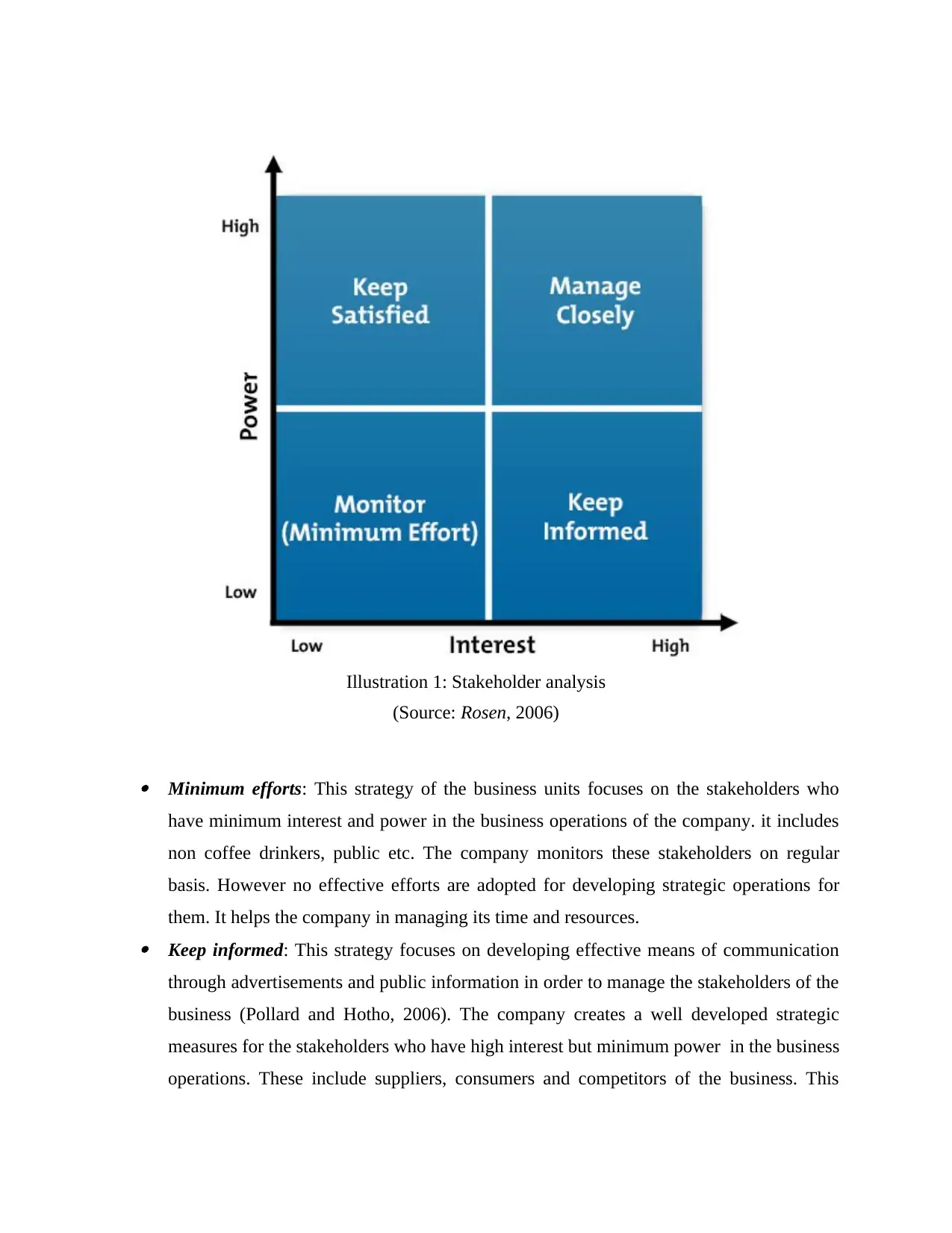
Minimum efforts: This strategy of the business units focuses on the stakeholders who
have minimum interest and power in the business operations of the company. it includes
non coffee drinkers, public etc. The company monitors these stakeholders on regular
basis. However no effective efforts are adopted for developing strategic operations for
them. It helps the company in managing its time and resources. Keep informed: This strategy focuses on developing effective means of communication
through advertisements and public information in order to manage the stakeholders of the
business (Pollard and Hotho, 2006). The company creates a well developed strategic
measures for the stakeholders who have high interest but minimum power in the business
operations. These include suppliers, consumers and competitors of the business. This
Illustration 1: Stakeholder analysis
(Source: Rosen, 2006)
have minimum interest and power in the business operations of the company. it includes
non coffee drinkers, public etc. The company monitors these stakeholders on regular
basis. However no effective efforts are adopted for developing strategic operations for
them. It helps the company in managing its time and resources. Keep informed: This strategy focuses on developing effective means of communication
through advertisements and public information in order to manage the stakeholders of the
business (Pollard and Hotho, 2006). The company creates a well developed strategic
measures for the stakeholders who have high interest but minimum power in the business
operations. These include suppliers, consumers and competitors of the business. This
Illustration 1: Stakeholder analysis
(Source: Rosen, 2006)
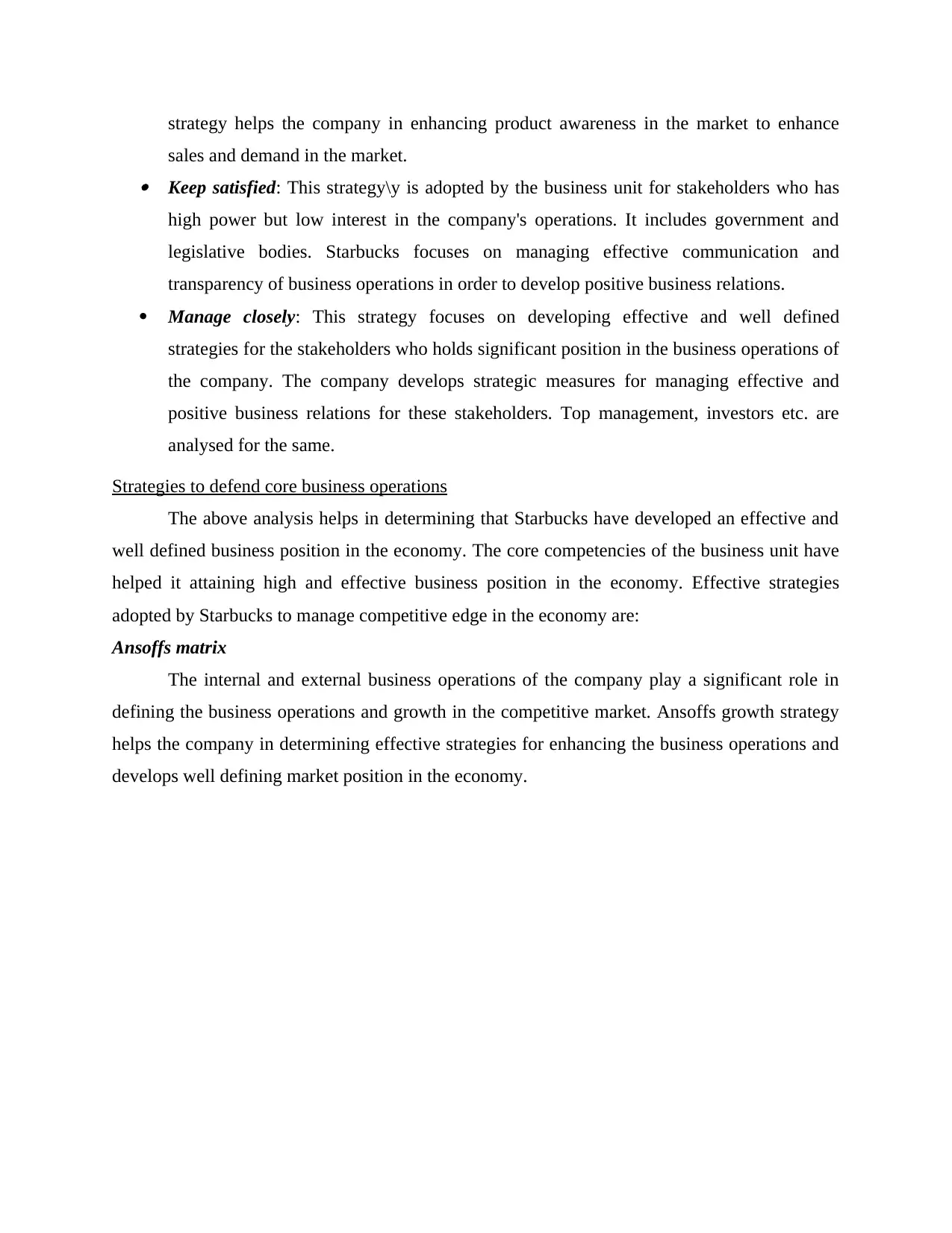
strategy helps the company in enhancing product awareness in the market to enhance
sales and demand in the market. Keep satisfied: This strategy\y is adopted by the business unit for stakeholders who has
high power but low interest in the company's operations. It includes government and
legislative bodies. Starbucks focuses on managing effective communication and
transparency of business operations in order to develop positive business relations.
Manage closely: This strategy focuses on developing effective and well defined
strategies for the stakeholders who holds significant position in the business operations of
the company. The company develops strategic measures for managing effective and
positive business relations for these stakeholders. Top management, investors etc. are
analysed for the same.
Strategies to defend core business operations
The above analysis helps in determining that Starbucks have developed an effective and
well defined business position in the economy. The core competencies of the business unit have
helped it attaining high and effective business position in the economy. Effective strategies
adopted by Starbucks to manage competitive edge in the economy are:
Ansoffs matrix
The internal and external business operations of the company play a significant role in
defining the business operations and growth in the competitive market. Ansoffs growth strategy
helps the company in determining effective strategies for enhancing the business operations and
develops well defining market position in the economy.
sales and demand in the market. Keep satisfied: This strategy\y is adopted by the business unit for stakeholders who has
high power but low interest in the company's operations. It includes government and
legislative bodies. Starbucks focuses on managing effective communication and
transparency of business operations in order to develop positive business relations.
Manage closely: This strategy focuses on developing effective and well defined
strategies for the stakeholders who holds significant position in the business operations of
the company. The company develops strategic measures for managing effective and
positive business relations for these stakeholders. Top management, investors etc. are
analysed for the same.
Strategies to defend core business operations
The above analysis helps in determining that Starbucks have developed an effective and
well defined business position in the economy. The core competencies of the business unit have
helped it attaining high and effective business position in the economy. Effective strategies
adopted by Starbucks to manage competitive edge in the economy are:
Ansoffs matrix
The internal and external business operations of the company play a significant role in
defining the business operations and growth in the competitive market. Ansoffs growth strategy
helps the company in determining effective strategies for enhancing the business operations and
develops well defining market position in the economy.
⊘ This is a preview!⊘
Do you want full access?
Subscribe today to unlock all pages.

Trusted by 1+ million students worldwide
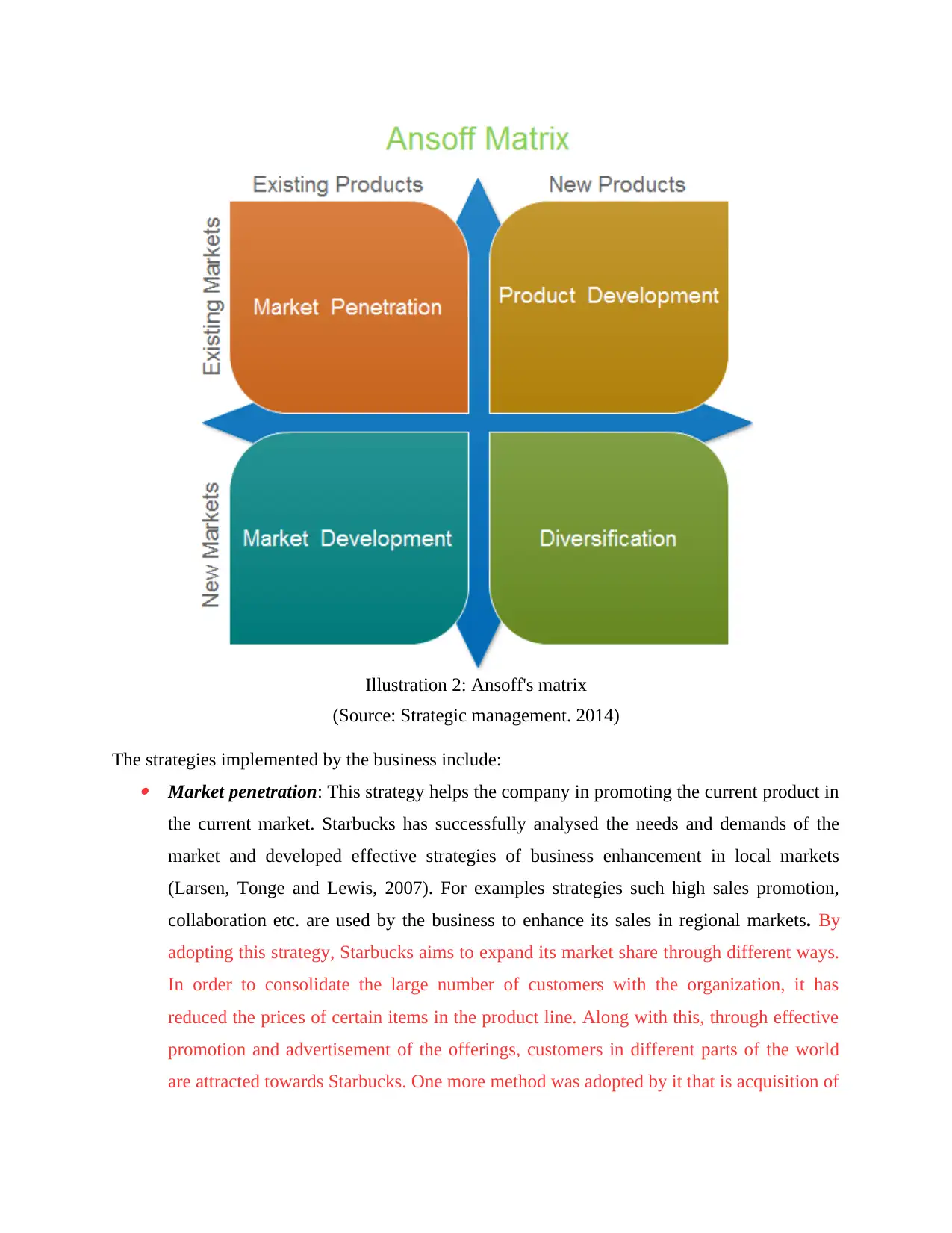
The strategies implemented by the business include: Market penetration: This strategy helps the company in promoting the current product in
the current market. Starbucks has successfully analysed the needs and demands of the
market and developed effective strategies of business enhancement in local markets
(Larsen, Tonge and Lewis, 2007). For examples strategies such high sales promotion,
collaboration etc. are used by the business to enhance its sales in regional markets. By
adopting this strategy, Starbucks aims to expand its market share through different ways.
In order to consolidate the large number of customers with the organization, it has
reduced the prices of certain items in the product line. Along with this, through effective
promotion and advertisement of the offerings, customers in different parts of the world
are attracted towards Starbucks. One more method was adopted by it that is acquisition of
Illustration 2: Ansoff's matrix
(Source: Strategic management. 2014)
the current market. Starbucks has successfully analysed the needs and demands of the
market and developed effective strategies of business enhancement in local markets
(Larsen, Tonge and Lewis, 2007). For examples strategies such high sales promotion,
collaboration etc. are used by the business to enhance its sales in regional markets. By
adopting this strategy, Starbucks aims to expand its market share through different ways.
In order to consolidate the large number of customers with the organization, it has
reduced the prices of certain items in the product line. Along with this, through effective
promotion and advertisement of the offerings, customers in different parts of the world
are attracted towards Starbucks. One more method was adopted by it that is acquisition of
Illustration 2: Ansoff's matrix
(Source: Strategic management. 2014)
Paraphrase This Document
Need a fresh take? Get an instant paraphrase of this document with our AI Paraphraser
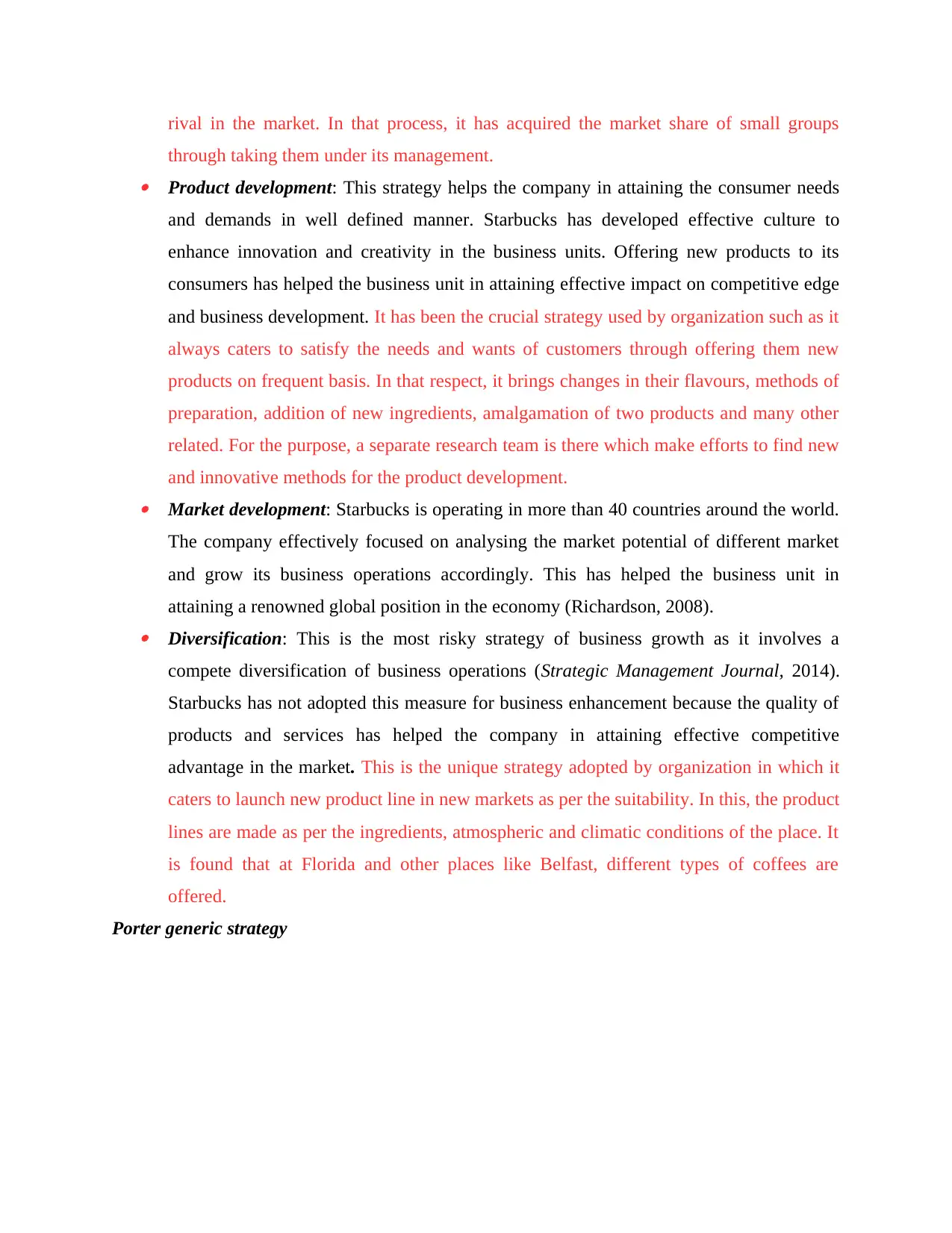
rival in the market. In that process, it has acquired the market share of small groups
through taking them under its management. Product development: This strategy helps the company in attaining the consumer needs
and demands in well defined manner. Starbucks has developed effective culture to
enhance innovation and creativity in the business units. Offering new products to its
consumers has helped the business unit in attaining effective impact on competitive edge
and business development. It has been the crucial strategy used by organization such as it
always caters to satisfy the needs and wants of customers through offering them new
products on frequent basis. In that respect, it brings changes in their flavours, methods of
preparation, addition of new ingredients, amalgamation of two products and many other
related. For the purpose, a separate research team is there which make efforts to find new
and innovative methods for the product development. Market development: Starbucks is operating in more than 40 countries around the world.
The company effectively focused on analysing the market potential of different market
and grow its business operations accordingly. This has helped the business unit in
attaining a renowned global position in the economy (Richardson, 2008). Diversification: This is the most risky strategy of business growth as it involves a
compete diversification of business operations (Strategic Management Journal, 2014).
Starbucks has not adopted this measure for business enhancement because the quality of
products and services has helped the company in attaining effective competitive
advantage in the market. This is the unique strategy adopted by organization in which it
caters to launch new product line in new markets as per the suitability. In this, the product
lines are made as per the ingredients, atmospheric and climatic conditions of the place. It
is found that at Florida and other places like Belfast, different types of coffees are
offered.
Porter generic strategy
through taking them under its management. Product development: This strategy helps the company in attaining the consumer needs
and demands in well defined manner. Starbucks has developed effective culture to
enhance innovation and creativity in the business units. Offering new products to its
consumers has helped the business unit in attaining effective impact on competitive edge
and business development. It has been the crucial strategy used by organization such as it
always caters to satisfy the needs and wants of customers through offering them new
products on frequent basis. In that respect, it brings changes in their flavours, methods of
preparation, addition of new ingredients, amalgamation of two products and many other
related. For the purpose, a separate research team is there which make efforts to find new
and innovative methods for the product development. Market development: Starbucks is operating in more than 40 countries around the world.
The company effectively focused on analysing the market potential of different market
and grow its business operations accordingly. This has helped the business unit in
attaining a renowned global position in the economy (Richardson, 2008). Diversification: This is the most risky strategy of business growth as it involves a
compete diversification of business operations (Strategic Management Journal, 2014).
Starbucks has not adopted this measure for business enhancement because the quality of
products and services has helped the company in attaining effective competitive
advantage in the market. This is the unique strategy adopted by organization in which it
caters to launch new product line in new markets as per the suitability. In this, the product
lines are made as per the ingredients, atmospheric and climatic conditions of the place. It
is found that at Florida and other places like Belfast, different types of coffees are
offered.
Porter generic strategy
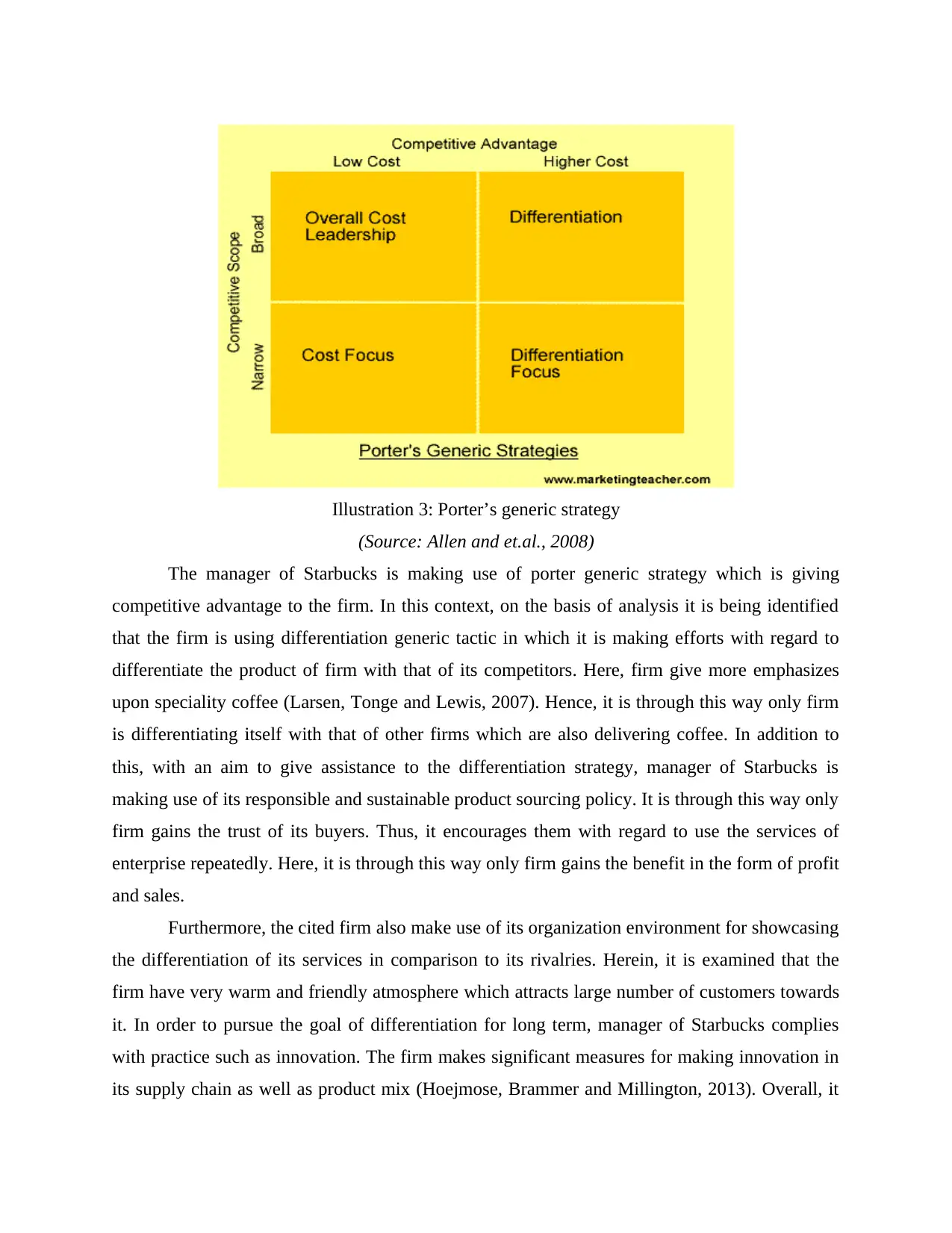
The manager of Starbucks is making use of porter generic strategy which is giving
competitive advantage to the firm. In this context, on the basis of analysis it is being identified
that the firm is using differentiation generic tactic in which it is making efforts with regard to
differentiate the product of firm with that of its competitors. Here, firm give more emphasizes
upon speciality coffee (Larsen, Tonge and Lewis, 2007). Hence, it is through this way only firm
is differentiating itself with that of other firms which are also delivering coffee. In addition to
this, with an aim to give assistance to the differentiation strategy, manager of Starbucks is
making use of its responsible and sustainable product sourcing policy. It is through this way only
firm gains the trust of its buyers. Thus, it encourages them with regard to use the services of
enterprise repeatedly. Here, it is through this way only firm gains the benefit in the form of profit
and sales.
Furthermore, the cited firm also make use of its organization environment for showcasing
the differentiation of its services in comparison to its rivalries. Herein, it is examined that the
firm have very warm and friendly atmosphere which attracts large number of customers towards
it. In order to pursue the goal of differentiation for long term, manager of Starbucks complies
with practice such as innovation. The firm makes significant measures for making innovation in
its supply chain as well as product mix (Hoejmose, Brammer and Millington, 2013). Overall, it
Illustration 3: Porter’s generic strategy
(Source: Allen and et.al., 2008)
competitive advantage to the firm. In this context, on the basis of analysis it is being identified
that the firm is using differentiation generic tactic in which it is making efforts with regard to
differentiate the product of firm with that of its competitors. Here, firm give more emphasizes
upon speciality coffee (Larsen, Tonge and Lewis, 2007). Hence, it is through this way only firm
is differentiating itself with that of other firms which are also delivering coffee. In addition to
this, with an aim to give assistance to the differentiation strategy, manager of Starbucks is
making use of its responsible and sustainable product sourcing policy. It is through this way only
firm gains the trust of its buyers. Thus, it encourages them with regard to use the services of
enterprise repeatedly. Here, it is through this way only firm gains the benefit in the form of profit
and sales.
Furthermore, the cited firm also make use of its organization environment for showcasing
the differentiation of its services in comparison to its rivalries. Herein, it is examined that the
firm have very warm and friendly atmosphere which attracts large number of customers towards
it. In order to pursue the goal of differentiation for long term, manager of Starbucks complies
with practice such as innovation. The firm makes significant measures for making innovation in
its supply chain as well as product mix (Hoejmose, Brammer and Millington, 2013). Overall, it
Illustration 3: Porter’s generic strategy
(Source: Allen and et.al., 2008)
⊘ This is a preview!⊘
Do you want full access?
Subscribe today to unlock all pages.

Trusted by 1+ million students worldwide
1 out of 15
Related Documents
Your All-in-One AI-Powered Toolkit for Academic Success.
+13062052269
info@desklib.com
Available 24*7 on WhatsApp / Email
![[object Object]](/_next/static/media/star-bottom.7253800d.svg)
Unlock your academic potential
Copyright © 2020–2025 A2Z Services. All Rights Reserved. Developed and managed by ZUCOL.




